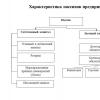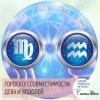Myasthenia and myasthenic syndromes. Myasthenia – what is it? Causes, symptoms, treatment Antibodies for myasthenia gravis analysis
Information mail
DIAGNOSIS CRITERIA FOR MYASTHENIAS
Modern ideas about the pathogenesis of the disease allow us to distinguish 4 groups of main criteria for diagnosing myasthenia gravis: clinical, pharmacological, electromyographic (EMG) and immunological diagnostic criteria.
Clinical diagnostic criteria
A detailed study of a large number of patients with myasthenia gravis showed that the most common clinical manifestations diseases are:
- dysfunction of extraocular and bulbar muscles,
- weakness and fatigue of the muscles of the trunk and limbs.
Severity of clinical symptoms.
Disturbances in the function of extraocular muscles, according to the results of observation of the Myasthenic center, are observed in 75% patients with myasthenia gravis. Of them:
- minimum degree oculomotor disorders, in the form of transient diplopia is observed in 31% of patients,
- moderate, in the form of recurrent ophthalmoparesis and persistent diplopia - in 64%,
- maximum, manifested ophthalmoplegia – in 5% of patients.
Bulbar disorders have 54% sick. Of them:
- lungs bulbar disorders manifested by periodic disturbances in swallowing and speech are detected in 57% of patients,
- moderate, in the form of constant, but fluctuating in severity, dysphonia, nasal voice and periodic swallowing disorders - in 30%,
- pronounced, manifested by aphonia and dysphagia - in 13% of patients.
Functional disorders respiratory muscles have 20% sick. Of them:
- respiratory disorders that are regarded as mild, manifested by periodic breathing disorders that occur after physical activity, are detected in 30% of patients, moderate, in the form of shortness of breath during the withdrawal of anticholinesterase drugs, or during the period of intercurrent infections, are also detected in 30% of patients, severe, requiring mechanical ventilation - in 40% of patients.
Muscle dysfunction torso and limbs have 60% sick. It is assessed on a 6-point scale, where minimal decrease in function is assessed as 4 points (identified in 18% of patients), moderate – as 2-3 points (in 62%) and pronounced – less than 2 points (in 20% of patients).
Muscle atrophy minimal and moderate severity are detected in 5% of patients. They arise, as a rule, against the background of severe bulbar disorders and are of a nutritional nature (4% of patients).
U moderate amyotrophies are observed in 1% of examined patients in whom myasthenia gravis was combined with thymoma.
Decreased tendon and periosteal reflexes detected in 7% of examined patients.
Vegetative-trophic disorders in the form of dry skin and mucous membranes, paresthesia, heart rhythm disturbances, intolerance to orthostatic stress, etc. - detected in 10% of patients with myasthenia, among whom the majority (82%) had myasthenia combined with thymoma.
It must be emphasized that enlargement of the thymus gland according to CT or MRI is not a criterion for diagnosing myasthenia gravis.
Pharmacological diagnostic criteria
For pharmacological testing use Prozerin or Kalimin-Forte.
Study of the effectiveness of the test with the introduction proserina and kalimina forte showed that full compensation of motor disorders is detected in 15% of patients with myasthenia gravis. It is necessary to note that full compensation involves restoring muscle strength to 5 points, regardless of the degree of its initial decrease. In the majority of patients with myasthenia gravis (75%), the response to the administration of proserin was incomplete , i.e. was accompanied by an increase in muscle strength by 2-3 points, but did not reach 5 points. Partial compensation was characterized by an increase in strength by 1 point in individual muscles, while it was absent in other tested muscles.
When conducting and evaluating a pharmacological test, the dose of the administered drug is of decisive importance, since only with the introduction of adequate doses of the drug is one or another assessment of the effectiveness of the test valid.
Kalimin-forte at a dose of 5 mg or prozerin 1.5 ml of a 0.05% solution is administered subcutaneously when the patient weighs 50-60 kg; at a dose of 10 mg or 2.0 ml - with a weight of 60-80 kg, respectively; and 15 mg or 2.5 ml - for patient weights from 80 to 100 kg.
In children the dose of the drugs is 5 mg or 1.0 ml, respectively.
If muscarinic effects of anticholinesterase drugs occur (hypersalivation, muscle twitching, increased rumbling in the abdomen), after assessing the effectiveness of the test, atropine is administered subcutaneously at a dose of 0.2–0.5 ml of a 0.1% solution. The test is assessed in the range from 40 minutes to 1.5 hours after administration of the drug. The assessment is based on changes in the severity of clinical symptoms, as well as the absence or presence of side effects. At full And incomplete compensation of motor disorders, the test is assessed as positive. At partial compensation – dubious, in the absence of compensation for movement disorders and the presence of side effects - negative.
Electromyographic diagnostic criteria
The third criterion for diagnosing myasthenia gravis is the study of EMG indicators that reflect the state of neuromuscular transmission during the decrement test. Data obtained from indirect supramaximal stimulation of muscles of varying degrees of clinical damage show that in the muscles of patients myasthenia, as a rule, M-responses of normal amplitude and area are recorded, but with stimulation at frequencies of 3 and 40 impulses/s, a decrement in the amplitude of the M-response of varying degrees is detected. In 30% of the muscles studied, post-tetanic relief (PTF) of more than 120% was observed, in 85% of the muscles post-tetanic wasting (PTI) was detected. It must be emphasized that the magnitude of the decrement phenomenon of subsequent M-responses in a series, most typical for myasthenia gravis, when stimulated at a frequency of 3 impulses/s, is proportional to the degree of clinical damage to the muscle. It should be noted that EMG examination before and after the administration of anticholinesterase drugs (Kalimin-Forte, Proserin) allows us to objectify the effectiveness of the pharmacological test.
Immunological diagnostic criteria
An important diagnostic criterion is the determination in the blood serum of antibodies against acetylcholine receptors of the postsynaptic membrane in patients with myasthenia gravis, and antibodies against the titin protein in patients with myasthenia gravis with the presence of thymoma.
To determine antibodies against acetylcholine receptors of the postsynaptic membrane, alpha-bungarotoxin (snake venom) labeled with radioactive iodine (125-I) is used. Antibodies are detected in the patient's blood serum using specific immunoassay kits. In the blood serum of healthy patients, the concentration of antibodies to acetylcholine receptors does not exceed 0.152 nmol/l. In patients with various autoimmune diseases (autoimmune thyroiditis, Hashimoto's disease, rheumatoid arthritis) and other neuromuscular diseases, the antibody concentration does not exceed 0.25 nmol/l. Evidence of the presence of myasthenia gravis (generalized or ocular form) is the concentration of antibodies to acetylcholine receptors more than 0.4012 nmol/l.
Most patients with myasthenia gravis with the presence of thymoma develop autoantibodies against titin, a protein of striated muscle with a high molecular weight. Detection of antibodies to titin is a differential diagnostic criterion for distinguishing thymoma from thymic hyperplasia. Antibodies are determined in the patient's blood serum using immunological kits (DLD, Germany). The value characterizing a high probability of having thymoma is a level of more than 1.0 arbitrary units.
Thus, the diagnosis of myasthenia gravis is undoubted when it is confirmed by all 4 diagnostic criteria; reliable - with 3 criteria; probable - if there are 2 and doubtful - if there is 1 criterion.
Myasthenia gravis is an autoimmune disease characterized by impaired neuromuscular transmission and manifested by weakness and pathological fatigue of striated muscles.
As a result of this disorder, healthy muscles become weak, leading to muscle paralysis. Practice shows that with this pathology any muscles can be affected, but most often the eye muscles are affected, a little less often - the facial, labial and tongue muscles, as well as the muscles of the pharynx, larynx and neck. When the respiratory muscles, as well as the muscles of the trunk and limbs, are affected, generalized myasthenia gravis occurs - a very dangerous condition that can even lead to death.
This disease was first described back in 1672 by an English physician and anatomy specialist Thomas Willis. The number of cases of myasthenia gravis is steadily growing and currently amounts to 5-7 people per 100 thousand population.
According to statistics, women suffer from myasthenia gravis much more often than men (70% to 30%), the disease usually first appears in adolescence, but is most pronounced at the age of 20-30 years. The disease is autoimmune in nature, so hormonal therapy is used for treatment.
By the way, this disease is diagnosed not only in people - myasthenia gravis is often recorded in dogs and cats.
Causes of myasthenia gravis
To date, the causes of myasthenia gravis are not fully understood. In medical practice, cases of familial myasthenia gravis are diagnosed, but the heredity of the disease has not been proven. Quite often, patients with asthenic bulbar palsy are diagnosed with hyperplasia or neoplasm of the thymus gland. Another factor contributing to the development of myasthenia gravis is the penetration of viruses and mycoplasmas into the human body.
The main pathogenetic feature of this disease is dysfunction of neuromuscular transmission, which determines the characteristic clinical manifestations. The synaptic block is associated with a failure in the synthesis of acetylcholine. Antibodies to skeletal muscles and epithelial cells of the thymus gland are detected in the blood serum, which gives grounds for classifying myasthenia gravis as an autoimmune disease.
The results of a study of the causes of myasthenia gravis prove that insufficient potassium levels in the body, hyperfunction of the thyroid gland and hormonal imbalance significantly increase the risks of this disease.
Symptoms of myasthenia gravis
Weakness and sudden fatigue can affect any muscle in the human body. More often - the muscles of the face and neck.
Characteristic symptoms of myasthenia gravis (see photo) are:
- ptosis (drooping eyelids);
- double vision;
- nasal voice and speech disorders;
- difficulty swallowing, fatigue of the masticatory muscles;
- fatigue of the neck muscles (difficulty keeping your head straight);
- weakness in arms and legs.
Symptoms appear after exercise, even after the most minimal. The greater the load, the worse the patient's condition. For example, at first, speech impairments are minimal - a person has a slight nasal tone, but pronounces words quite clearly, then he begins to “swallow” individual sounds, and then cannot speak at all. Rest can reduce these symptoms. Symptoms are especially severe 3-4 hours after waking up.
Depending on the manifestations, the following forms of the disease are distinguished:
- ocular (the disease manifests itself only by drooping eyelids, double vision; for such patients, therapy with anticholinesterase drugs is usually sufficient);
- bulbar (impaired speech, chewing, swallowing, breathing - the danger of this form is that breathing difficulties can increase rapidly);
- generalized (affects all muscles, this is the form of myasthenia gravis that is meant when they talk about myasthenia gravis or Erb-Goldflam disease; the disease affects all muscles, from facial and neck muscles to the muscles of the arms and legs);
- fulminant (the most dangerous form, as it leads to disability and even death, it is usually caused by a malignant tumor of the thymus gland, all muscles are affected, including skeletal muscles, while therapy simply does not have time to have its effect, it is simply impossible to prevent the dangerous consequences of myasthenia gravis).
More common is the generalized form, which usually begins with weakness of the facial muscles.

Symptoms in children
Myasthenia gravis occupies a special place in children, the early symptoms of which have some of their own characteristics:
1) Congenital myasthenia. Rapid fatigue of the muscular system can be suspected in utero during an ultrasound. With myasthenia gravis, fetal movements are less active, or may even be absent altogether. After birth, the symptoms of this myasthenia gravis are similar to neonatal myasthenia. Death occurs due to impaired spontaneous breathing.
2) Myasthenia of newborns. It occurs in those children whose mothers themselves suffer from myasthenia. It begins from the first days of life and can last about 2 months. Its main symptoms may be the following:
- the baby is more lethargic than other newborns,
- breathes shallowly
- chokes periodically
- his cry is weak, more like a squeak,
- he also sucks poorly and gets tired quickly,
- his mouth is slightly open,
- the gaze is almost motionless,
- in some cases, swallowing may also be difficult.
The child most often dies from suffocation.
- Early childhood myasthenia. According to experts, it occurs before the age of 2 years, when, against the background of complete health, vision problems begin to appear: the eyelids involuntarily droop, gaze paralysis and strabismus develop. In some cases, the baby may refuse to walk, run, have difficulty going up or down stairs, and often asks to be held. Refusal to eat can occur if the masticatory muscles are involved in the process.
- Juvenile and childhood myasthenia. Develops from 2 to 10 years or in adolescence, mainly in girls. Among the early signs, it is necessary to pay attention to the child’s complaints about sudden fatigue, blurred vision, difficulties with running, walking long distances, squats, and doing physical work around the house.
Myasthenic crisis
Myasthenia gravis is a chronic disease, it constantly progresses. If the patient does not receive proper treatment, his condition worsens. A severe form of the disease may be accompanied by the onset of myasthenic crisis. It is characterized by the fact that the patient experiences severe weakness of the muscles responsible for swallowing and movement of the diaphragm. Because of this, his breathing is difficult, his heart rate increases, and drooling is often observed. Due to paralysis of the respiratory muscles, the patient's death may occur.
An overdose of anticholinesterase drugs may cause a cholinergic crisis. It is expressed in a slow heartbeat, salivation, convulsions, and increased intestinal motility. This condition also threatens the patient’s life, so he needs medical attention. The anticholinesterase drug must be discontinued, and its antidote, Atropine solution, must be administered intramuscularly.
Diagnostics
It is necessary to consult a neurologist. First of all, the doctor will examine the patient, ask about complaints and other identified symptoms. During the initial examination of a patient, it is quite difficult to identify myasthenia gravis, because its symptoms are similar to those of many other diseases. Therefore, a comprehensive examination is carried out.
The simplest and most valuable method for diagnosing myasthenia gravis is the proserine test. When performing this test, the patient is subcutaneously injected with a solution of proserin (0.05%, 1-2 ml), then after 20-30 minutes the neurologist re-examines the patient, determining the body’s reaction to the test. Prozerin blocks cholinesterase, the increased activity of which leads to disruption of neuromuscular junctions, so the symptoms of myasthenia gravis quickly subside, and the person feels completely healthy. It is worth noting that the effect of prozerin, although powerful, is short-lived, so it is not used for treatment, but is indispensable for diagnosis.
The following studies are also carried out for diagnosis:
- Electromyography (decrement test) – registration of bioelectric potentials in skeletal muscles. It is advisable to carry out electromyography twice: first before the proserine test, then 30-40 minutes after it, since this can reveal a violation of neuromuscular transmission.
- Electroneurography is a study of the speed of impulses passing through nerves.
- A blood test for specific antibodies, sometimes a biochemical blood test is also required.
- Genetic studies are carried out to identify congenital myasthenia gravis.
- Computed tomography of the mediastinal organs - to examine the thymus gland for its increase in volume or the presence of a tumor (thymoma).
To diagnose myasthenia gravis, special tests have been developed that allow a neurologist to identify the disease in the initial stages. Although you can perform such tests yourself at home:
- Quickly open and close your mouth within 40 seconds - normally you should have time to do 100 cycles of such movements, and with muscle weakness it is much less.
- You need to lie on your back, slightly raise your head and hold it there for 1 minute.
- Do 20 squats with the same amplitude.
- Quickly clench and unclench your hands - often due to muscle weakness in myasthenia gravis, this exercise leads to drooping eyelids.
Differential diagnosis is carried out with diseases with similar symptoms: bulbar syndrome, encephalitis, meningitis, cerebral glioma, hemangioblastoma, Guillain-Barré syndrome, etc.

Treatment of myasthenia gravis
The main goal of treating myasthenia gravis is to increase the amount of acetylcholine. It is quite difficult to synthesize this component, so drugs are used in treatment to prevent its destruction. For this purpose, medications containing neostigmine are used in neurology.
If the disease progresses rapidly, medications are prescribed that block the immune response; this is the treatment in this case.
When choosing medications, you need to take into account that medications containing fluoride are contraindicated for myasthenic patients. People over 70 years of age have their thymus gland removed. In addition, medications are selected to block individual symptoms - eyelid twitching, stopping drooling, etc.
“Pulse therapy” helps improve the patient’s condition. This treatment involves the use of hormonal drugs. At first, a large dose of artificial hormones is prescribed, but gradually it is reduced and reduced to nothing. If a myasthenic crisis occurs, hospitalization may be necessary. Patients with this condition are prescribed plasmapherosis and ventilation to treat symptoms.
A relatively new method of treating myasthenia gravis is cryopherosis. Treatment involves the use of low temperatures, which help rid the blood of harmful components. Beneficial substances contained in plasma are returned to the patient’s blood. The method is safe because there is no possibility of transmission of infection and the occurrence of an allergic reaction. Cryopherosis improves the general condition of the patient. After 5-6 procedures, a good, lasting result is established.
Often during treatment, doctors prescribe Kalimin, an anticholinesterase drug, also known as Mestinon, Pyridostigmine. As with any autoimmune disease, corticosteroids are prescribed, in particular Prednisolone, for treatment.
Folk remedies
Along with drug therapy, it is possible to treat myasthenia gravis at home with folk remedies in order to speed up recovery and alleviate the condition. However, any traditional treatment methods must be agreed with the observing specialist.
Effective means:
- Oats. The grains are thoroughly washed and filled with water in a volume of 0.5 liters. Next, the container is placed on the fire, the composition is brought to a boil, and steamed for at least half an hour. Next, to prepare the infusion, wait another 2 hours, removing the oats from the heat. The resulting decoction is taken an hour before meals, at least 4 times a day. The duration of therapy is 3 months with a break of 1 month and another course of treatment.
- Onion. The product in a volume of 200 grams (purified) is mixed with 200 grams of sugar and filled with water in a volume of 0.5 liters. The composition is placed on low heat and cooked for 1.5 hours. Next, cool the mass, add two tablespoons of honey and take two teaspoons three times a day.
- Three heads of garlic are crushed and mixed with four lemons, a liter of honey and linseed oil (200 g). All ingredients must be thoroughly mixed and taken daily, one teaspoon three times a day.
Rules of conduct for myasthenia gravis
If the diagnosis is made on time and the patient follows all the doctor’s instructions, his performance and lifestyle remain almost unchanged. Treatment of myasthenia gravis consists of constantly taking special medications and following certain rules.
Such patients are prohibited from sunbathing, performing heavy physical work and taking medications without a doctor’s recommendation. Patients should definitely know what contraindications for taking medications for myasthenia gravis. Many drugs can cause complications of the disease or the development of myasthenic crisis. These are the following medications:
- all magnesium and lithium preparations;
- muscle relaxants, especially curare-like ones;
- tranquilizers, antipsychotics, barbiturates and benzodiazepines;
- many antibiotics, for example, Neomycin, Gentamicin, Norfloxacin, Penicillin, Tetracycline and others;
- all diuretics, except Veroshpiron;
- Lidocaine, Quinine, oral contraceptives, antacids, some hormones.

Nutrition
Patients with the disease need to adjust their diet in accordance with the stage of the disease. The body's protective functions are weakened, so nutrition for myasthenia gravis plays an important role in recovery. It is important to eat baked potatoes, raisins, bananas and dried apricots. It doesn’t hurt to find sources of microelements such as phosphorus and calcium.
Calcium intake should be combined with phosphorus, this ensures better absorption of substances. It is important to take potassium supplements and vitamins.
Complications
With the help of acetylcholine, as described above, human respiratory muscles also function. Therefore, due to problems with the work of these muscles, a sharp disturbance in breathing may occur, even to the point of stopping it. As a result, death may occur.
Adults should always pay special attention to the child’s complaints. With the development of childhood myasthenia, the child often complains that he cannot pedal a bicycle, climb a hill, etc. It is important to understand the causes of this condition, because with myasthenia gravis in children, respiratory failure develops suddenly.
Forecast
It is almost impossible to predict the exact outcome of this disease, since it depends on many factors: time of onset, clinical form, gender and age of the patient, as well as the presence or absence of therapeutic measures. The most favorable course occurs in the case of the ocular form of myasthenia, and the most severe course of the disease accompanies the generalized form.
With proper treatment and constant medical monitoring, almost all forms of this disease have a favorable prognosis.
Myasthenia gravis is the most common autoimmune disease characterized by damage to the neuromuscular synapses due to the production of autoantibodies to acetylcholine receptors or to specific enzymes - muscle-specific tyrosine kinase.As a result, pathological fatigue and weakness of skeletal muscles develop, mutations in proteins of neuromuscular junctions can lead to the development of congenital myasthenic syndromes.
What it is?
Myasthenia gravis is a fairly rare autoimmune disease characterized by muscle weakness and lethargy. With myasthenia gravis, there is a disruption in the communication between nerve and muscle tissues.
The official scientific name of this disease is myasthenia gravis pseudoparalitica, which is translated into Russian as asthenic bulbar palsy. In Russian medical terminology, the concept of “myasthenia gravis” is widely used.
Causes of myasthenia gravis
To date, experts do not have clear information about what exactly provokes the symptoms of myasthenia gravis in a person. Myasthenia gravis is an autoimmune disease, because multiple autoantibodies are found in the serum of patients. Doctors record a certain number of familial cases of myasthenia gravis, but there is no evidence of the influence of hereditary factors on the manifestation of the disease.
Quite often, myasthenia gravis manifests itself in parallel with hyperplasia or a tumor of the thymus gland. Also, myasthenic syndrome can occur in patients who complain of organic diseases of the nervous system, polydermatomyositis, and cancer.
More often, females suffer from myasthenia gravis. As a rule, the disease manifests itself in people aged 20–30 years. In general, the disease is diagnosed in patients aged 3 to 80 years. In recent years, experts have shown significant interest in this disease due to the high incidence of myasthenia gravis in children and young people, which leads to subsequent disability. This disease was first described more than a century ago.
Pathogenesis
Autoimmune processes play a role in the development of myasthenia gravis; antibodies were found in muscle tissue and the thymus gland. The muscles of the eyelids are often affected, resulting in ptosis that varies in severity throughout the day; chewing muscles are affected, swallowing is impaired, and gait changes. It is harmful for patients to be nervous, as this causes chest pain and shortness of breath.
The provoking factor may be stress, suffered from acute respiratory viral infection, dysfunction of the body's immune system leads to the formation of antibodies against the body's own cells - against acetylcholine receptors of the postsynaptic membrane of neuromuscular junctions (synapses). Autoimmune myasthenia is not inherited.
Most often, the disease manifests itself during adolescence in girls (11-13 years old); it is less common in boys at the same age. The disease is increasingly being detected in preschool children (5-7 years old).

Classification
This disease develops differently in everyone. Most often, myasthenia gravis begins with weakness of the eye and facial muscles, then this disorder spreads to the muscles of the neck and torso. But some people have only some signs of the disease. Accordingly, there are several types of myasthenia gravis.
- The ocular form is characterized by damage to the cranial nerves. The first sign of this is drooping of the upper eyelid, most often on one side first. The patient complains of double vision and difficulty moving the eyeballs.
- The bulbar form of myasthenia gravis is a lesion of the masticatory and swallowing muscles. In addition to the disruption of these functions, the patient’s speech changes, the voice becomes quiet, nasal, and there are difficulties in pronouncing certain sounds, for example, “r” or “b”.
- But most often there is a generalized form of the disease, in which the eye muscles are first affected, then the process spreads to the neck, upper and lower extremities. The hips and arm muscles are especially often affected; it is difficult for the patient to climb stairs or hold objects. The danger of this form of the disease is that weakness spreads to the respiratory muscles.
Symptoms
Unfortunately, most often myasthenia gravis is diagnosed in cases where the disease continues for several years in a row and becomes advanced. For this reason, any unexplained fatigue, muscle flaccidity, or weakness that increases sharply with repeated movements should be regarded as a possible symptom of myasthenia gravis until this diagnosis is completely refuted.
Early symptoms include:
- swallowing disorder
- difficulty chewing solid food to the point of refusing to eat,
- when talking - “fading of voice”,
- fatigue when combing, climbing stairs, normal walking,
- the appearance of a shuffling gait,
- drooping eyelids.
The most often affected are the oculomotor, facial, and masticatory muscles, as well as the muscles of the larynx and pharynx. The following tests help identify latent myasthenia gravis:
- If a patient is asked to quickly open and close his mouth within 30 seconds, a healthy person will make about 100 movements, and a person suffering from myasthenia gravis will make less.
- Lie on your back, raise your head and hold it in this position for 1 minute, while looking at your stomach.
- Extend your arms and stand there for 3 minutes.
- Do 15–20 deep squats.
- Quickly clench and unclench your hands - this often causes drooping eyelids in a patient with myasthenia gravis.
The local form of myasthenia gravis is characterized by the manifestation of muscle weakness of a certain group of muscles, and in the generalized form, the muscles of the trunk or limbs are involved in the process.
Myasthenic crisis
As clinical practice shows, myasthenia gravis is a progressive disease, which means that under the influence of certain paralysis factors (external environment or endogenous causes), the degree and severity of symptomatic manifestations of the disease can increase. And even patients with mild myasthenia gravis can experience a myasthenic crisis.
The cause of this condition may be:
- injuries;
- stressful conditions:
- any acute infections;
- taking medications with neuroleptic or tranquilizing effects;
- surgical interventions in the body, etc.
Symptoms are manifested by the first appearance of double vision. Then the patient feels a suddenly increasing attack of muscle weakness, the motor activity of the muscles of the larynx decreases, which leads to disruption of the processes:
- voice formation;
- breathing and swallowing;
- salivation increases and the pulse quickens;
- The pupils may dilate, tachycardia may occur, and complete paralysis may occur without loss of sensitivity.
The development of acute insufficiency of oxygen supply to the brain can lead to a direct threat to life, so resuscitation measures are urgently necessary.
Diagnostics
In order to make a correct diagnosis, the patient is prescribed a comprehensive study, since the clinical picture of myasthenia gravis may be similar to other diseases. The main diagnostic methods are:
- Extensive biochemical blood tests to detect antibodies;
- Electromyography is a study during which you can evaluate the potential of muscle fibers when they are excited;
- Genetic screening, which is carried out to identify the congenital form of myasthenia;
- Electroneurography is a study that allows you to evaluate the speed of transmission of nerve impulses to muscle fibers;
- MRI – with the help of this study, you can notice even the slightest signs of thymic hyperplasia;
- Test for muscle fatigue - the patient is asked to quickly open and close his mouth several times, wave his arms and legs, clench and unclench his hands, and squat. The main syndrome of myasthenia gravis is the appearance of increasing muscle weakness with repetition of these movements.
- Proserin test - the patient is injected subcutaneously with proserin, after which they wait for up to half an hour, and then evaluate the result. A patient with myasthenia gravis feels a significant improvement in his condition, and after a few hours the clinical symptoms resume with the same intensity.

How to treat myasthenia gravis?
In severe cases of myasthenia gravis, removal of the thymus gland during surgery is indicated. The most effective medications successfully used to relieve symptoms of the disease include prozerin and kalinin. Along with them, medications that enhance immunity and a number of other medications that improve the patient’s well-being are used. It is important to remember that the earlier treatment is started, the more effective it will be.
At the first stage of the disease, anticholinesterase drugs, cytostatics, glucocorticoids and immunoglobulins are used as symptomatic therapy. If the cause of myasthenia gravis is a tumor, then surgery is performed to remove it. In cases where the symptoms of myasthenia gravis rapidly progress, extracorporeal hemocorrection is indicated to clear the blood of antibodies. Already after the first procedure, the patient notices an improvement in his condition; for a more lasting effect, treatment is carried out for several days.
New, effective methods of treatment include cryophoresis - purification of the blood from harmful substances under the influence of low temperatures. The procedure is carried out in a course (5–7 days). The advantages of cryophoresis over plasmaphoresis are obvious: in the plasma that is returned to the patient after purification, all useful substances are preserved unchanged, which helps to avoid allergic reactions and viral infection.
Also new methods of hemocorrection used in the treatment of myasthenia gravis include cascade plasma filtration, in which purified blood, after passing through nanofilters, returns to the patient. After the first minutes of the procedure, the patient notices an improvement in well-being; the full course of treatment for myasthenia gravis requires five to seven days.
Modern methods of treating myasthenia gravis also include extracorporeal immunopharmacotherapy. As part of the procedure, lymphocytes are isolated from the patient's blood, which are treated with medications and sent back into the patient's bloodstream. This procedure is considered the most effective in the treatment of myasthenia gravis. It allows you to reduce the activity of the immune system by reducing the production of lymphocytes and antibodies. This technique gives stable remission for a year.
Prevention of myasthenia gravis and its complications
It is impossible to prevent the disease, but you can do everything possible to live a full life with such a diagnosis.
- Firstly, doctor's control. Such patients are managed by neurologists. In addition to the prescribed treatment regimen and systematic visits to a neurologist, it is necessary to monitor the general condition (blood sugar, blood pressure, etc.) in order to prevent the development of other diseases during the treatment of myasthenia gravis.
- Secondly, you should avoid excessive stress – physical and emotional. Stress, hard physical work, and overly active sports worsen the condition of patients. Moderate exercise and walking are even beneficial.
- Thirdly, you should avoid exposure to the sun.
- Fourthly, it is necessary to know the contraindications for patients with myasthenia gravis and strictly observe them.
- Fifthly, strictly follow the treatment regimen prescribed by the doctor, do not skip medications and do not take more medications than prescribed by the attending physician.
The doctor is obliged to issue a list of medications contraindicated for such a patient. It includes magnesium preparations, muscle relaxants, tranquilizers, some antibiotics, diuretics with the exception of veroshpiron, which, on the contrary, is indicated.
You should not get carried away with immunomodulatory drugs or any sedatives, even those that seem safe (for example, valerian or peony tincture).
Forecast
Previously, myasthenia gravis was a serious disease with a high mortality rate of 30-40%. However, with modern methods of diagnosis and treatment, mortality has become minimal - less than 1%; about 80%, with proper treatment, achieve complete recovery or remission. The disease is chronic, but requires careful monitoring and treatment.
– a chronic progressive disease with the presence of crises, characterized by pathological fatigue and muscle weakness.
It was first described back in 1672 by Thomas Willis. Currently, the incidence of myasthenia gravis is growing from 5 to 10 patients per 100,000 population.
Causes of myasthenia gravis
Myasthenia gravis is a genetic disease, but it has not been studied enough at the genetic level. Great importance is attached to the mutation of the gene responsible for the functioning of neuromuscular synapses. Two mechanisms for the development of the disease have been discovered:
- biochemical changes in the area of myoneural synapses caused by changes in the function of the hypothalamus with secondary involvement of the thymus gland (thymus) in the process;
- autoimmune damage to the thymus gland with impaired neuromuscular transmission. At the same time, the synthesis of acetylcholine decreases and the activity of cholinesterase increases.
The triggering factor can be stress, colds, impaired immune functions of the body, which will lead to the formation of antibodies to its own cells, against acetylcholine receptors of the postsynaptic membrane of neuromuscular junctions (synapses). Normally, these synapses transmit impulses from nerve to muscle through biochemical reactions involving the mediator acetylcholine.
When excited, acetylcholine enters the synaptic cleft through the presynaptic membrane to the cholinergic receptors of the postsynaptic membrane (muscle), causing its excitation. The enzyme acetylcholinesterase destroys the neurotransmitter, limiting its duration. With myasthenia gravis, this complex mechanism is disrupted. At the ends of the synapses, little acetylcholine is produced or it is intensively destroyed by cholinesterase, and as a result, this synapse is blocked and the conduction of a nerve impulse becomes impossible.
Myasthenia gravis usually begins between 20 and 40 years of age. Women are more often affected than men (2:1).
Symptoms of myasthenia gravis
The main symptom of myasthenia gravis is weakness and sharply increased fatigue of skeletal muscles during work or prolonged stress. Muscle weakness increases with repeated movements, especially at a fast pace. The muscle seems to “get tired” and stops obeying until it becomes completely paralyzed. After rest, muscle function is restored. In the morning, after sleep, the patient feels generally normal. Several hours of wakefulness lead to an increase in myasthenic symptoms.
There are three forms of myasthenia gravis:
- ophthalmic;
- bulbar;
- generalized.
The muscles that are innervated by the cranial nerves are most often affected first. In the future, damage to the muscles of the neck and, to a lesser extent, the muscles of the trunk and limbs is possible. The first signs of the disease are drooping of the upper eyelid and double vision, which occur when the external muscles of the eyeball, the orbicularis oculi muscle, and the muscle that lifts the upper eyelid are affected. If in the morning the patient can open the eye completely and freely, then further blinking leads to weakening of the muscle and the eyelid simply “hangs.” This is the eye shape.
In the photo Ptosis with myasthenia gravis
In the bulbar form, the muscles innervated by the bulbar group of nerves are affected. In this case, problems with swallowing and chewing will appear. Speech will change - it will become quiet, hoarse, nasal, hoarse, the voice will quickly deplete to the point of silent speech.
In the most common, generalized form, the process begins with the oculomotor muscles and then all muscles are involved in it. The muscles of the neck and facial muscles are the first to suffer. The patient has difficulty holding his head up. A peculiar facial expression appears with a transverse smile and deep wrinkles on the forehead. Drooling appears. Later, weakness of the muscles of the limbs occurs. The patient walks poorly and cannot take care of himself. The condition is better in the morning, but worsens in the evening. Each subsequent movement becomes more and more difficult for the patient to perform. Over time, the muscles atrophy. The proximal parts - shoulders, hips - are most affected.
Tendon reflexes quickly deplete and appear after rest.
In the photo Generalized form of myasthenia gravis
Examination for myasthenia gravis
For diagnosis, electromyography is important, which will detect a myasthenic reaction, a pharmacological test - a significant improvement after the administration of anticholinesterase drugs (proserin 0.05% 1 ml IM) and an immunological test - determination of the titer of antibodies to acetylcholine receptors, as well as the detection of thymoma (tumor of the thymus glands) - computed tomography of the anterior mediastinum.
Myasthenic crisis
The course of myasthenia gravis is progressive with an increase in symptoms and its severity. In severe forms, patients experience myasthenic crises.
Myasthenic crisis is a sudden attack of severe weakness of the respiratory and pharyngeal muscles - difficulty breathing (frequent, whistling), increased heart rate, drooling. Paralysis of the respiratory muscles during a severe crisis is a direct threat to the patient’s life.
Myasthenia gravis is a chronic, serious disease that is progressive, often leading to disability, and requires careful monitoring and treatment.
Myasthenic syndrome can be observed with lethargic encephalitis, bronchogenic carcinoma (tumor) of the lung (Lambert-Eaton syndrome), amyotrotrophic lateral sclerosis, thyrotoxicosis. There are a number of congenital myasthenic syndromes based on mutations in the genes of different subunits of acetylcholine receptors.
Treatment of myasthenia gravis
The main medications for myasthenia gravis are anticholinesterase drugs - kalimine, prozerin. The prescribed dosage and time of administration must be strictly observed due to the danger of overdose and the development of cholinergic intoxication - cholinergic crisis - convulsions, twitching, slow pulse, constriction of the pupils, drooling, pain, abdominal cramps. The antidote to this overdose is atropine subcutaneously or intravenously 0.5 - 1.0 ml.
Treatment with anticholinesterase drugs has been carried out for years, adjusting the drugs depending on the severity of the disease: oxazil, proserine, kalimine, galantamine. To enhance their effect, potassium salts are used, and spironolactone is used in courses to retain potassium in the body. In severe cases, hormone therapy and cytostatics are used.
“Pulse therapy” is effective - large doses of hormones (1000 – 2000 mg of prednisolone) with a further gradual dose reduction. Immunosuppressants – azothioprine, cyclosporine, cyclophosphamide. If thymoma is detected, surgical treatment is indicated.
In severe cases of myasthenic crisis, artificial ventilation, plasmapheresis, administration of immunoglobulins, intravenous proserin, and subcutaneous ephedrine are performed in intensive care units.
No special diet is required, but it is advisable to eat foods rich in potassium: dried apricots, raisins, potatoes.
If myasthenia gravis is detected
The main institution for the study, diagnosis and treatment of myasthenia gravis and myasthenic syndromes is the Moscow Myasthenic Center, created on the basis of the department of neuromuscular pathology of the Research Institute of General Pathology and Pathophysiology of the Russian Academy of Medical Sciences in 1983. In Russia, medications for the treatment of myasthenia gravis are included in the federal preferential list and are available free of charge with a doctor’s prescription: metypred, prednisolone, kalimin, neuromidin, veroshpiron, cyclophosphamide, azothioprine.
Patients with myasthenia gravis should be observed by a neurologist, regularly take prescribed treatment and follow all recommendations. Under such conditions, long-term preservation of working capacity and quality of life is possible.
Patients with myasthenia gravis should not sunbathe, work hard physically, use magnesium preparations, muscle relaxants, neuroleptics and tranquilizers, diuretics (except veroshpiron), aminoglycosides (gentamicin, kanamycin, neomycin, streptomycin...), fluoroquinolines (norfloxacin, ofloxacin), tetracycline, quinine derivatives, D -penicillamine. All patients are given such a list by their doctor and should always have it with them so as not to take an inappropriate drug.
You cannot self-medicate or use herbal medicine. No medicine should be given to a patient with myasthenia gravis without consulting a doctor! Curare-like substances enhance myasthenic phenomena.
Sanatorium and resort treatment is not indicated in the hot season in the south. We recommend sanatorium and resort treatment in sanatoriums with a medical profile: treatment of nervous diseases (brain diseases); sanatoriums: "Alatyr" (Mordovia), "Anzhersky" (Kemerovo region), "Bakirovo" (Tatarstan), "Arshan" (Republic of Buryatia), "Barnaulsky" (Altai Territory), "Beshtau" and "Dawns of Stavropol" (Stavropol region)", "Golden Ear", sanatorium-resort complex "Knowledge" (Krasnodar region), sanatorium named after Borodin (Kostroma region), "Emerald" (Primorsky region), sanatoriums in the Moscow region and St. Petersburg and many other health resorts in Russia and countries CIS.
Consultation with a doctor on myasthenia gravis
Question: Is it possible to completely recover from myasthenia gravis?
Answer: no, but as a result of proper and long-term treatment, complete disappearance of symptoms and long-term remission can be achieved.
Question: Can myasthenic crisis be caused by improper treatment?
Answer: maybe. Insufficient doses of anticholinergic drugs will be ineffective and myasthenic crisis may develop. An overdose of them will lead to a cholinergic crisis. Both crises require immediate hospitalization, possibly in the intensive care unit due to the threat of respiratory arrest.
Question: is it possible to sunbathe during long-term remission?
Answer: no. Exposure to the sun can cause exacerbation of myasthenia gravis, even with many years of remission.
Question: is myasthenia gravis inherited?
Answer: no.
Question: is normal pregnancy and childbirth possible?
Answer: possible. Pregnancy should be planned and consulted with a doctor. Taking cytostatics for pregnant women is contraindicated and it is better to decide on the issue of switching to other medications in advance. Everything is decided individually. Myasthenia gravis is not inherited.
Neurologist Kobzeva S.V.
What is myasthenia gravis is one of the most important questions for many people who note adverse complaints associated with impaired motor function.
Myasthenia gravis- this is of a neuromuscular nature, in which the patient experiences pathological muscle weakness.
The main feature is a weakening of the muscles and an increased tendency to show weakness, and such a complaint appears due to damage to the cholinergic receptors of the postsynaptic membranes.
The pathological process can involve almost any muscle of the human body. Often, a sick person’s facial expressions are impaired, which sooner or later allows the correct diagnosis to be confirmed.
Causes of myasthenia gravis
To date, the reliable causes of the development of myasthenia gravis have not been elucidated. Despite this, factors have been identified that increase the risk of developing the disease.
Scientists note the possibility of familial cases, but the hereditary nature is still not proven.
In many situations, there is a combination of myasthenia gravis with a tumor of the thymus gland, as well as with hyperplasia. Sometimes patients are diagnosed with organic diseases of the nervous system, cancer of the lung and mammary glands, ovary or prostate.
It is noted that women experience the disease more often than men. Moreover, the first manifestations of myasthenia gravis are usually diagnosed at 20–30 years of age.
Forms of myasthenia
The disease is divided into several types, each of which turns out to be dangerous:
- congenital;
- neonatal;
- acquired.
Despite this division, myasthenia gravis almost always leads to a gradual deterioration in health and a more pronounced manifestation of the clinical picture.
The rarest form of the disease is congenital. In this case, ultrasound detects weak activity of the fetus even before birth, as a result of which it becomes possible to make a presumptive diagnosis. Newborn babies immediately suffer from the manifestations of the disease, so the greatest risks regarding death are noted. Difficulty breathing, which is caused by muscle atrophy, leads to irreversible consequences. No treatment is offered for complex cases.
Neonatal myasthenia It is usually transmitted to babies from mothers who have myasthenia gravis. The pathology usually affects the eye and respiratory muscles. The newborn is not prone to normal activity, as he is weak. Only correct and timely treatment can improve your health. If a treatment course is not carried out, there is a risk of progression of the disease to moderate and severe degrees.
One of the most common forms of myasthenia gravis is acquired (juvenile). This disease usually affects women. However, sometimes symptoms appear in middle-aged and elderly people. Myasthenia gravis often manifests itself in early adolescence. Various factors lead to the development of the disease, including dangerous infections. There is a risk of a sharp deterioration in health, with many people suffering from anxiety and increased excitability.
If complaints arise, you should contact an experienced doctor, who will certainly conduct a comprehensive examination and confirm the diagnosis. Subsequently, you should begin a treatment course and carefully monitor all changes in your well-being.
Description of the clinical picture (photo)

Symptoms of myasthenia gravis usually lead to severe physical limitations in affected individuals.
Gradually, the clinical picture becomes more and more pronounced. Over time, the complaints intensify even after the slightest physical exertion.
The main signs of the disease are general muscle weakness and increased fatigue. Such manifestations are observed in both children and adults (see photo below).
Children also experience the following complaints:
- excessively low mobility;
- manifestation of weakness;
- and even the impossibility of disrupting the sucking of the mammary glands, as a result of which many children suffer from malnutrition;
- muscle atrophy, which is observed visually.
The above complaints do not appear immediately. The clinical picture develops gradually, and the lack of treatment only complicates the health condition.
Young people initially experience increasing fatigue. Even simple movements, including walking and arm movements, lead to fatigue. Due to muscle pathology, serious changes in gait occur due to the need to adapt to weakening muscle activity. Soon the facial expression changes, what affects the eyes and eyelids, facial expressions.
When wondering what this muscle-related disease is, there are additional diagnostic challenges in older adults. Many complaints can be explained by age-related changes, as a result of which the pathology remains undetected until a sharp deterioration in health.
In older adults, diagnosis is usually made only after severe symptoms have developed:
- weakening of the general muscle tone of the whole body;
- inability to clearly focus the eye;
- the appearance of a feeling of heaviness in the eyelids;
- weakening of the swallowing reflex;
- decreased voice pitch;
- breathing problems that become difficult and excessively frequent;
- physical exhaustion;
- development of the aspiration form.
Despite the degree of manifestation of the clinical picture, there is a need for a timely and accurate diagnosis. Otherwise, myasthenia gravis leads to irreversible consequences and disability.
Diagnostic features
Typically, diagnosis begins with consultation and clarification of patients’ complaints. If the doctor correctly interprets the clinical manifestations, the chance of effective treatment increases. The doctor’s experience plays a decisive role, since existing complaints can be mistakenly attributed to another disease or even chronic fatigue syndrome.
One of the most effective diagnostic methods is magnetic resonance imaging (MRI). At the same time, the results obtained must be correctly interpreted, since this determines how correct the treatment can be carried out.
If it is not possible to establish a diagnosis based on existing complaints, a pharmacological test is performed. The main task is a thorough study of the human body’s reaction to additional stimuli.
To carry out the examination, special drugs are administered, after which the state of nerve and neuromuscular transmission in the body is carefully examined. The pharmacological test is reliable for generalized myasthenia gravis.
Features of the pharmacological test:
- the patient is administered the drug prozerin, which improves the flow of neuromuscular impulses;
- the doctor studies the specifics of compensation for motor dysfunction, which should subsequently occur;
- the level of compensation in healthy people reaches five points, but in patients a complete restoration of normal muscle strength is not observed, and compensation does not exceed 2–3 points.
Before starting a treatment course, you should consult an experienced doctor and undergo examinations. Only after it is possible to correctly diagnose what kind of disease is causing the patient’s complaints, it becomes possible to select effective therapy.
Crises during illness
Myasthenia gravis is a chronic disease, so the risk of progression and the appearance of new complaints remains on an ongoing basis. If proper treatment is not carried out, the condition of the sick person will constantly deteriorate. In severe forms of the disease, crises may occur regularly, which are manifested by aggravated symptoms of myasthenia gravis.
One of the most dangerous crises is myasthenic crisis. It is manifested by severe muscle weakness, as a result of which the functioning of the diaphragm is disrupted and swallowing becomes more difficult, breathing becomes difficult, the heartbeat quickens, and salivation becomes profuse. Paralysis of the respiratory muscles can lead to the death of the affected person.
An overdose of anticholinesterase drugs leads to a cholinergic crisis. The main signs are slow heartbeat and salivation, convulsive muscle twitching, increased intestinal motility. This condition can also be fatal, so it is necessary to promptly stop taking the drug and administer an antidote to the drug intramuscularly.
Any crisis cannot be avoided without professional medical assistance.
Features of treatment
 Photos before and after myasthenia gravis treatment
Photos before and after myasthenia gravis treatment After the diagnosis has been made, you should understand what myasthenia gravis can lead to, what the disease should be and get a complete answer to the question “what is it in the patient?”
Myasthenia gravis is a serious disease that requires constant medical care and treatment without any interruption. Otherwise, the risk of disability for a sick person increases significantly. Only the right therapy can achieve long-term remission.
The main task is to regularly take medications to block cholinesterase. After the diagnostic measures have been carried out, the doctor prescribes a number of medications that are taken according to a special regimen.
Additionally, potassium supplements are prescribed to enhance the effect of the main drugs and improve muscle contractility.
A more serious approach to treatment is required if the patient is diagnosed with generalized myasthenia gravis. In severe cases, it becomes mandatory to take hormonal drugs, and sometimes doctors use large dosages in order to improve health. The question of reducing the number of pills taken will be considered in at least a couple of months.
One of the areas of treatment is pulse therapy. This technique involves administering a high dosage of Metypred for three to five days. The drug can be withdrawn only gradually, and remission must initially be achieved. If there is only partial improvement in the condition, the drug is taken for several months, or even years.
Doctors also prescribe cytostatic immunosuppressants that have an effect at the cellular level. Treatment is carried out according to this scheme if patients are prohibited from taking glucocorticoids. If necessary, medications from different groups are alternated, following a specially designed treatment regimen.
Additionally, it is necessary to take special medications that help improve metabolic rates.
There is no traditional treatment. Many medicinal plants are strictly prohibited, as otherwise there is a risk of deterioration in health. Natural tonic medications may only be taken on medical advice.
When a crisis occurs, only hospital treatment is required. Only in this case can doctors provide effective assistance.
If there is no effect from classical treatment methods, surgery is required to remove the thymus gland. In most cases, patients after surgery note an improvement in their condition. However, many drugs are initially contraindicated, which is why difficulties with performing anesthesia are noted. Surgery is performed only if the patient is seriously ill and must be under seventy years of age.
Rules of behavior for patients
A timely diagnosis and successful implementation of all medical contraindications make it possible to avoid drastic lifestyle changes and prevent the onset of disability. After diagnosis, it is mandatory to begin taking prescribed medications in 100% strictness with the approved regimen and adherence to additional rules of behavior.
To prevent the development of the disease, you should remember the following basic rules:
- refusal to tan in the sun;
- complete exclusion of heavy physical work;
- the ability to take medications only after obtaining appropriate permission from a doctor.
Compliance with the above rules prevents the active development of myasthenia gravis.
Is it possible to cure the disease?
Previously, it was believed that myasthenia gravis was an incurable disease. Besides 30% of cases led to death. Currently, the prognosis is more favorable, with most patients experiencing stable remission with proper drug therapy.
Disability and death occur only in the absence of medical care or non-compliance with medical recommendations.
Experts continue to actively study myasthenia gravis and look for opportunities to provide medical care to patients. Timely diagnosis allows for effective treatment to take advantage of the chances of going into remission.
Videos on the topic
Interesting





















